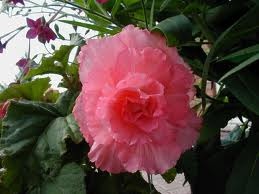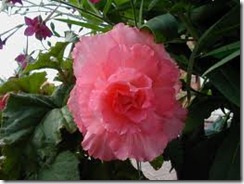Tuberous begonias (Begonia tuberhybrida) are flowers that grow from tubers, which are similar to bulbs. These plants are desirable for their ability to grow in partial shade and for their large, ruffled blooms. Often given as gifts, tuberous begonias are frequently grown in containers as houseplants. They are relatively easy to care for as long as they are fed and watered frequently, according to the University of Florida.
Climate
-
In cold climates, tuberous begonias can only be grown as annuals. These plants are native to the tropics of South America and Africa, according to the University of Minnesota, and will not survive prolonged freezing temperatures. Home gardeners who live in United States Department of Agriculture (USDA) growing zones 9 through 11 may find success growing them as perennials.
Soil and Water
-
Tuberous begonias grow best in cool, rich soil. The soil must be kept moist at all times, or the flowers may drop even before they open. On the other hand, soil that is too wet will cause the delicate tubers to rot. Soil that is muddy or soggy, or soil that collects standing water, will be too wet for tuberous begonias to grow well. In addition, wet conditions can cause powdery mildew to develop. Avoid wetting the leaves of the begonias when watering to avoid developing this fungal disease.
Light
-
Direct sunlight is too intense for these flowers. Late afternoon or early morning exposure is best for these plants, according to the University of Minnesota, which recommends dappled shade for the other parts of the day. For this reason, they are often planted in hanging baskets and placed on porches.
Fertilizer
-
Feed your begonias often for maximum bloom. They will flower all summer long if given enough fertilizer and water, according to the University of Florida. Choose a water-soluble fertilizer made for flowering plants. Fertilize every other week during the blooming period. Follow the instructions on the label for application.
Maintenence
-
Remove wilted flowers (simply pluck or pinch them off) to encourage the plant to produce more blooms. Dig up the tubers in the fall only after the foliage and stems have turned yellow and wilted. This is necessary for the nutrients to return to the bulb. Wash and dry the tubers, then store them in a cool, dark location for the winter. Replant in early spring just below the surface of the soil. Plant tubers a minimum of 6 inches apart and amend the soil with peat moss before planting.


Deprecated: strpos(): Passing null to parameter #1 ($haystack) of type string is deprecated in /home/agriviek8Qv/agriviet.net/public_html/wp-includes/comment-template.php on line 2522